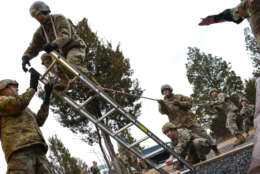Defense
-
Jerry McGinn of the Center for Government Contracting at George Mason University joined Federal Drive with Tom Temin for his take.
January 29, 2020 -
DoD’s deputy chief information officer for information enterprise said working out the bugs in production is “just not how we’re wired” at the Pentagon, but in the case of AI is needed.
January 29, 2020 -
The Army is finding ways to combat adversaries messing with the images computers are trying to recognize and thus making the training process for artificial intelligence programs harder.
January 28, 2020 -
The Army has used authorities from Congress to pay bonuses to service members with specific cyber skills and it now is looking for ways to incentivize civilian workers to stay.
January 28, 2020 -
In today's Federal Newscast, three senators want the Government Accountability Office to evaluate the process non-citizen service members go through to become naturalized.
January 28, 2020 -
This year's National Defense Authorization Act moved DoD's chief data officer from the CMO's office to the CIO's office. But Chief Information Officer Dana Deasy appears to be starting from scratch with a new hire.
January 28, 2020 -
The Air Force needs to keep the Space Force in its organization while also letting it build its own culture.
January 27, 2020 -
This program provides a progress report on cybersecurity strategies for defense and homeland.
January 27, 2020 -
The Navy Department will add $300 million as in "incremental investment" in its restructured higher education system. And whether or not officers take advantage of the new programs it's creating will factor into future promotion decisions.
January 27, 2020 -
The Congressional Brain Injury Task Force sent a letter to DoD expressing concern about possible blast injuries and concussions of the 11 service members injured in the Jan. 8 attack on Al-Asad Airbase in Iraq.
January 24, 2020 -
Tinkering by Congress has rendered Defense procurement into a sort of laboratory — and each of the armed services is running its own experiments.
January 24, 2020 -
Greg Garcia, the deputy CIO and chief data officer for the Army, and Eileen Vidrine, the Air Force’s CDO, are finding ways to increase the value of data that is leading to better decisions and cost savings.
January 24, 2020 -
The Army is starting a three-phase reform effort to tackle challenges in the Risk Management Framework, but says it's seen some major successes already.
January 24, 2020 -
The Army is starting its new process for evaluating soldiers to command battalions based on a multitude of factors including physical fitness, subordinate surveys and panel screenings.
January 23, 2020 -
Recent and tragic shootings at military installations show that physical threats remain potent, even in the continental U.S.
January 23, 2020
















